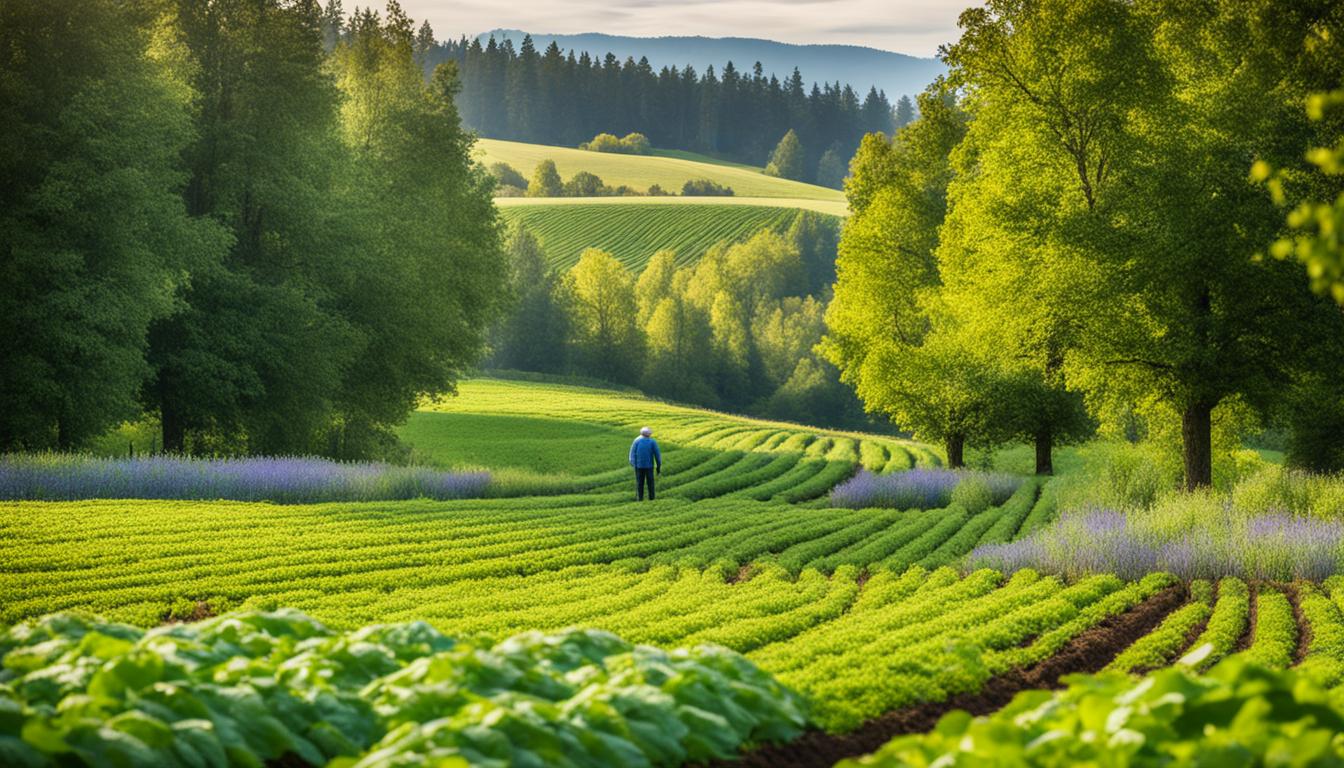Regenerative Agriculture: Sustainable farming practices that restore and enhance soil health.
Do you think our farming is hurting the planet more than helping it? The United States is losing soil ten times faster than it’s replaced. Regenerative farming is a bright spot, offering hope for a sustainable future.
Regenerative Agriculture aims to boost the earth’s health. It uses various farming techniques to make the soil healthier, create fairness, and keep the environment in balance. Teresa K. Quintana shows that ancient Indigenous ways, which work with nature, are coming back.
Groups like the NRDC are working with over 100 regenerative farmers. They want to change the food system to help the climate. Leonard Diggs talks about how regenerative farming can store carbon and help with things like water quality.
This farming isn’t just about the soil. It also supports fairness. The number of Black farmers has dropped a lot in the past century. The movement tries to fix this by giving everyone a fair shot at farming.
Regenerative farming cuts down on harmful chemicals. This helps people stay healthier and lets farmers make more money. It also boosts local economies by creating jobs and offering better food choices.
By working in harmony with the land, regenerative farming supports all life. It’s key to battling climate change and keeping our food supply safe for the future.
Key Takeaways
- Regenerative farming practices aim to significantly reduce soil erosion, which is up to 100 times higher in industrial agriculture.
- The NRDC has collected insights from over 100 farmers to develop strategies to combat the climate crisis.
- Only about 45,000 of the 3.4 million farmers in the U.S. are Black, a steep decline from nearly one million in 1920.
- White farmers control around 98% of the agricultural land in the United States.
- Adopting regenerative practices can increase crop yields and promote vibrant microbial communities in the soil.
- These methods provide rural economic opportunities and healthier food options while addressing historical injustices in agriculture.
- Regenerative agriculture fosters biodiversity and enhances ecosystem relationships, taking a holistic approach to land management.
What is Regenerative Agriculture?
Regenerative Agriculture is a big change in how we manage land. It’s about letting farming and nature work together. This method uses ancient wisdom and new ways to heal the soil and ecosystems.
About 655 million acres in the U.S. are used for grazing lands. Regenerative agriculture tries to make soil better. It does this by using smart grazing, planting without tilling the soil, and not using too many fake pesticides. This makes food systems more reliable.
It’s all about using fewer chemicals. This helps the environment and saves money for farmers. Healthy soil filters water and stops pollution from getting in the water. It also helps trap carbon. This is good for fighting climate change.
Regenerative farming is not just good for the earth. It helps wildlife and can make money. Farmers see more types of animals on their land. Big companies like Nestlé and PepsiCo are starting to do it too. They know it’s better for the future.
Almost a quarter of the world’s greenhouse gases come from land use and farming. Regenerative ways can cut a lot of these gases. They can put more than 10% of the world’s carbon back into the soil in 25 years. This would remove nearly a billion tons of carbon dioxide every year. It’s a huge help for the planet.
Principles of Regenerative Agriculture
To bring life back to our farmlands, it’s key to understand regenerative agriculture. This farming method follows core principles for the long life of the soil and healthier ecosystems.
Nurturing Soil Health
Central to regenerative farming is caring for the soil. This includes practices like minimal soil disturbance and keeping plants growing all year. Such techniques boost soil health, cut erosion, and help the ground hold more water. In the UK, more than 70% of farmable land grows permanent grass. This shows how crucial sustainable farming is for keeping soils healthy.
Reducing Synthetic Inputs
Regenerative farming aims to use fewer chemical inputs. It does this by improving natural processes and encouraging strong microbe communities. For instance, grazing livestock in certain ways can make the soil healthier. This way, farmers need less chemical help. Such changes also make grazing better for the environment, reducing harmful gases and improving pastures.
Promoting Biodiversity
Boosting biodiversity is essential in regenerative farming. Farmers achieve this with varied crops, companion planting, and mixing animals into fields. These steps help on many levels. They increase farm output, cut soil loss, and help nature stay in balance. A 2017 UN report warned that a third of the world’s land is in bad shape because of soil loss and other issues. So, bringing back biodiversity is critical.
This farming method is all about working with nature for healthier lands. It helps support a wide variety of life, making sure farming can last for the long haul.
Soil Health: The Foundation of Regenerative Agriculture
Soil health is vital for regenerative agriculture. It supports sustainability and the ability to recover from challenges. Practices like adding organic matter, using water wisely, and stopping erosion make soils strong. This helps both crops and the planet.
Improving Soil Organic Matter
Adding organic matter makes soils fertile and full of life. Soils stay healthy when they’re not plowed too much. Cover cropping and composting are great ways to add more organic materials. This helps the soil’s structure and feeds countless tiny and big organisms. They improve how nutrients move and make the soil steady.
Enhancing Water Retention
Using water wisely is key for soil health. Good soil has strong clumps and lots of tiny spaces that let water soak in well. Having plants in the soil all the time boosts the soil’s health and makes water use more effective. This also lessens the effects of dry times. Adding more organic stuff to the soil helps it keep water longer, making farming more steady.
Reducing Soil Erosion
Preventing soil erosion keeps farmland productive. Healthy soils don’t easily wash or blow away. Plants or their leftovers on the ground help stop erosion. Also, methods like careful grazing and not plowing too much keep the soil in good shape. This stops soil from being lost. By preventing erosion, we keep the land producing well and protect nature’s benefits.
The Role of Biodiversity in Regenerative Agriculture
Biodiversity is key to making regenerative agriculture work. It’s the base for strong ecosystems both above and below the ground. By mixing things up, we not only grow more food but we also help the environment a lot.
Biodiversity Above Ground
What grows above the ground is super important too. Different plants and farming methods help stop bad bugs and weeds. They also make a happy home for bees and other good animals. These animals help keep our planet’s natural balance. With these animals in trouble – their numbers have dropped by 68% in 50 years – it’s critical to keep things varied up top.
Biodiversity Below Ground
Life under the ground is just as crucial. By not disturbing the soil too much, we keep the earth full of life. From earthworms to tiny helpful bacteria, it’s a lively world down there. These little creatures make the soil healthy and help plants grow better. But many insects are disappearing – 76% fewer in 27 years – making it urgent to protect what’s below.
“Conserving below-ground diversity is pivotal in building resilient agricultural systems and supporting ecosystem services.”—Dr. Elaine Ingham, Soil Scientist
Agroforestry and Habitat Creation
Agroforestry, or mixing trees with crops, has a bunch of perks. It boosts habitat variety, making our planet stronger and more resistant. For example, a farm in Germany has many nut trees, like chestnut and walnut. Agroforestry is like a dream house for different animals, plus it fights soil loss and lack of water.
| Region | Wildlife Population Decline (Last 50 years) |
|---|---|
| Global | 68% |
| Caribbean and Latin America | 94% |
More than a third of Earth’s surface is worked on for farming or raising animals. This shows big potential for regenerative agriculture. As more people ask for eco-friendly food, these mixed practices will be key. They help keep nature in balance while we grow food.
Climate Change Mitigation Through Regenerative Agriculture
Regenerative agriculture can change how we fight climate change. It uses advanced farming methods like no-till and growing various crops. These help farms trap carbon from the air into the ground. If everyone followed this, the earth could handle all our carbon emissions. It’s believed that the right soil care could lock away 178 billion tons of carbon by 2100.
This type of farming is great because it raises soil’s carbon levels. This might lower the CO2 levels in the air by 157 parts per million. If we hit these numbers, they say the world could start cooling again. Besides, methods like regenerative grazing increase both carbon storage and enrich the soil. This makes the land better at fighting off climate change.
Farmers around the globe are seeing good results from these methods. In Zambia, pig farmers have turned 0.5% of soil organic matter into 2.5%. This change does a lot. It stores a good deal of carbon. It also makes the soil hold more water. This helps fight bad droughts. Global farming in 2012 put out about 52 billion tons of CO2. Regenerative farming can store far more carbon than this. So, it’s a smart choice for farming. It’s good for the land and helps fight climate change.
Source Links
- Regenerative Agriculture 101
- Regenerative Agriculture – EARTHDAY.ORG
- Regenerative Agriculture: Good for Soil Health, but Limited Potential to Mitigate Climate Change
- What is Regenerative Agriculture? – Noble Research Institute
- What is regenerative agriculture?
- Frontiers | What Is Regenerative Agriculture? A Review of Scholar and Practitioner Definitions Based on Processes and Outcomes
- Principles of Regenerative Agriculture – Groundswell
- What are the 4 Principles of Regenerative Agriculture?
- The 5 key principles of regenerative agriculture
- The Fundamental Principles of Regenerative Agriculture and Soil Health – Noble Research Institute
- Regenerative Agriculture
- Our Commitment to Regenerative Agriculture | Whole Foods Market
- Biodiversity is as Important as Climate Change—How Regenerative Agriculture Can Help – Center for Regenerative Agriculture and Resilient Systems
- How does regenerative agriculture increase biodiversity?
- Regenerative Agriculture: Enhancing Biodiversity for the Future
- Regenerative agriculture: Key to solving the climate crisis – Climate and Capital Media







